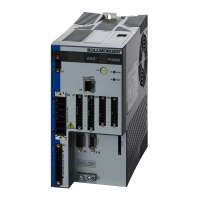10.10.1 Related topics:
10.12 Emergency Stop
10.1 Digital Inputs and Outputs
17.1 Fault and Warning Messages
10.11 Dynamic Braking
Dynamic braking is method to slow a servo system by dissipating the mechanical energy in a resistor driven by
the motor back EMF. The drive has a built in advanced (patent pending) dynamic braking mode which operates
fully in hardware. When activated, the drive shorts the motor terminals in phase with the back EMF (q axis) but
continues to operate the non-force producing current loop (d-axis) with 0 current. This forces all of the dynamic
braking current to be stopping current and insures the fastest stopping/amp of motor terminal current.
The drive hardware also limits the maximum dynamic braking motor terminal current via the DRV.DBILIMIT
parameter to prevent the drive, motor, and customer load from encountering excessive currents/forces. When
the current is not being limited, the mechanical energy is dissipated in the motor terminal resistance. When the
current is being limited, energy is returned to the drive bus capacitors. When the amount of returned energy
raises the bus capacitor voltage enough, the drive activates the regeneration control to start transferring the
returned energy to the regen resistor. This resistor could be internal or external to the drive depending on drive
model and drive wiring.
Whether and how the drive uses dynamic braking mode depends on the drive disable mode (DRV.DISMODE)
setting.
10.11.1 Drive Regeneration
When the servo motor is slowing down at a rate faster than friction and motor losses would slow the motor, then
mechanical energy can be returned to the drive. This returned energy initially drives the internal bus voltage
upwards. When the returned energy is high enough, the regeneration control transfers the excess returned
energy into the regeneration power resistor. If the regeneration control cannot fully handle the power returned (for
example, because there is not a regen resistor present or its resistance value is too high), then the bus voltage
will continue to rise and a bus over voltage fault will happen and disable the drive completely, which allows the
motor to freewheel.
10.11.1.1 AKD-x00306 to AKD-x00606
These units do not have an internal regeneration resistor. In many applications machine friction, motor losses,
and the limited bus capacitor energy absorption handles the application. But, depending on the exact application
requirements, an external resistor can be connected.
10.11.1.2 AKD-x01206 to AKD-x02406 and AKD-xzzz07
These units have an internal regeneration resistor plus the capability to connect an external resistor if higher
power levels are needed.
Related Topics
See section 6.14 Dynamic Braking in the AKDInstallation Manual for detailed information on dynamic
braking.
DRV.DISMODE
DRV.DBILIMIT
AKD User Guide | 10 Configuring General Drive Settings
Kollmorgen | December 2010 109

